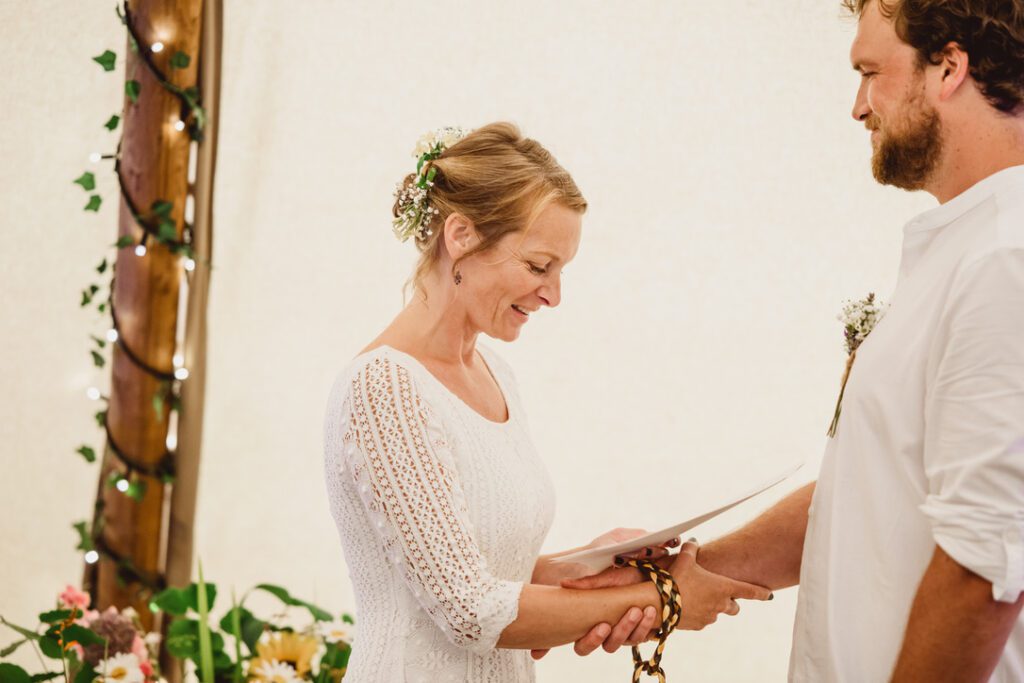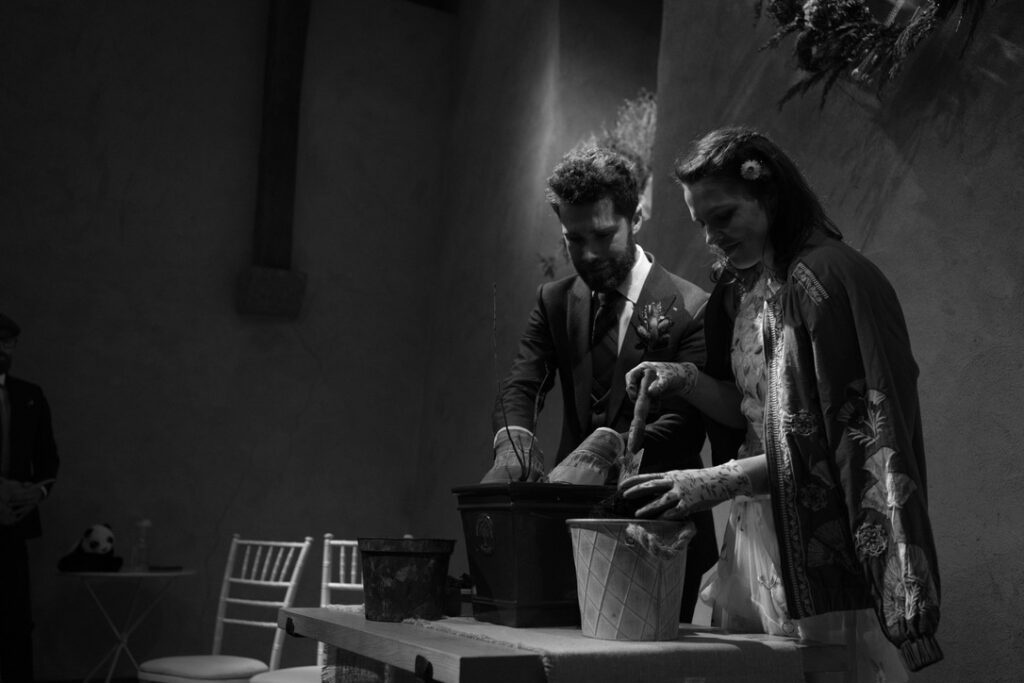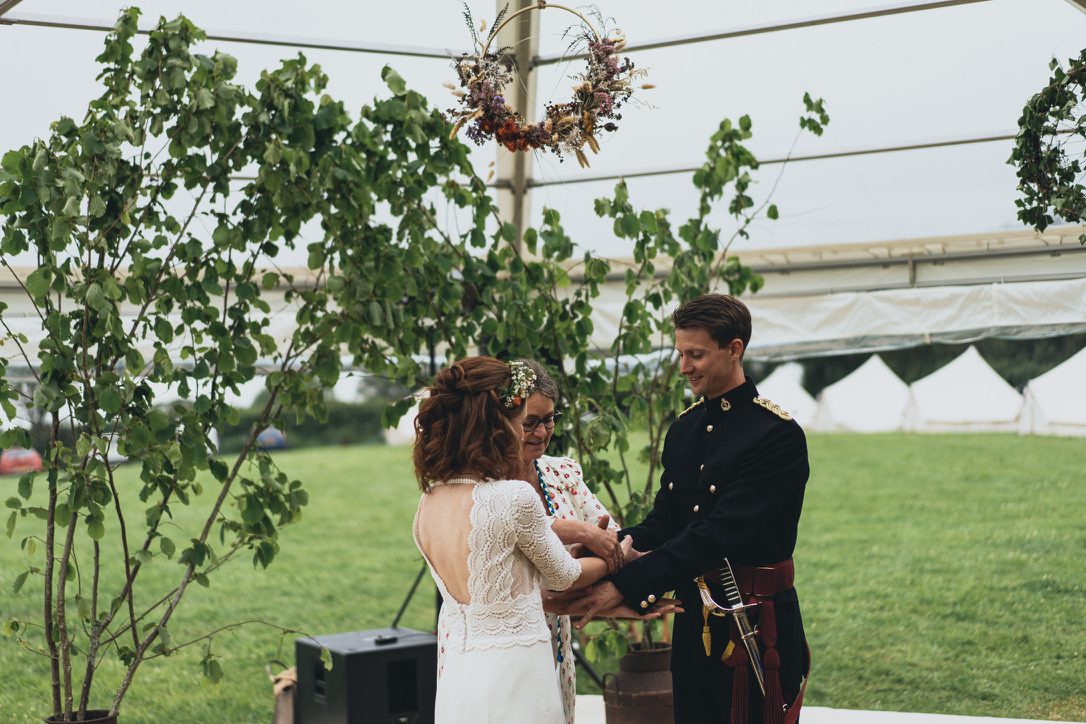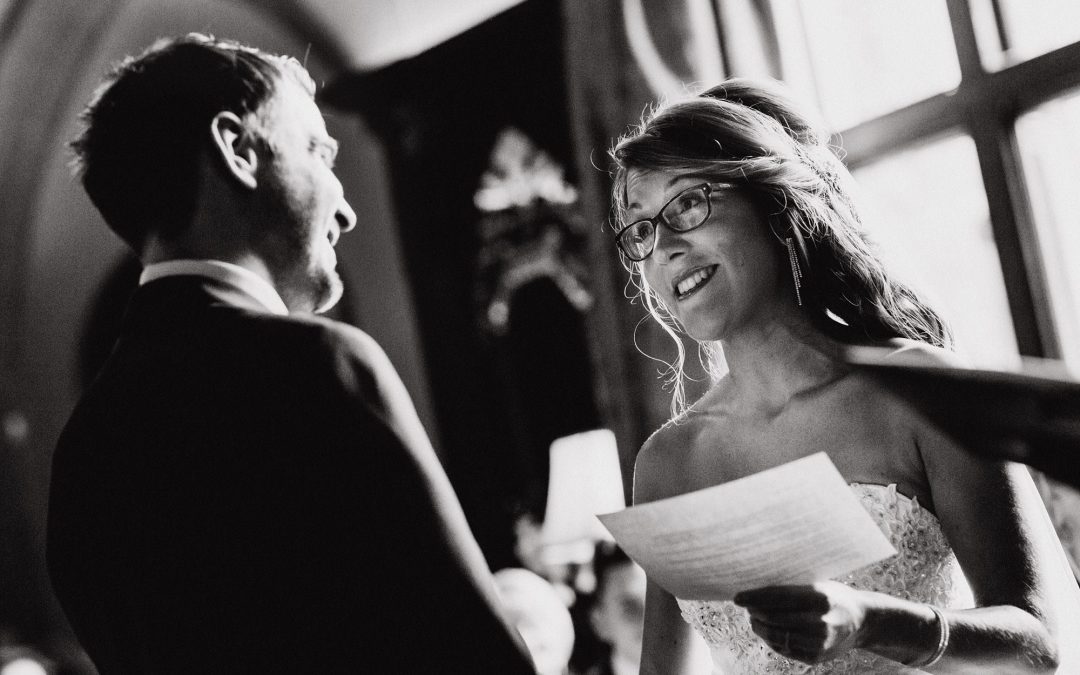Handfasting Ceremonies are some of the most beautiful and talked-about symbolic rituals in modern weddings. Two hands gently bound together, cords intertwined to represent love and unity; it’s romantic, photogenic, and steeped in history.
I completely understand why it appeals to so many couples. Over the years, I’ve performed many handfasting ceremonies, as well as other rituals that have been chosen for deeply personal reasons. I particularly love when couples choose to reimagine or modernise a piece of their own cultural heritage through symbolic ritual — taking something rooted in their ancestry and making it feel relevant, inclusive, and true to who they are today.
But I’ve made a conscious choice not to promote handfasting ceremonies (or any other symbolic ritual) as part of my standard offering. Not because I don’t appreciate them, but because my focus lies somewhere else entirely.
And that brings me to a word that’s perhaps a little overused these days yet absolutely central to what I do: authenticity.
Because in a world filled with trends, Instagram posts, Pinterest-perfect moments, and photo opportunities, authenticity is what keeps a ceremony honest. It’s what makes it yours.
That doesn’t mean I believe other celebrants who embrace symbolic ritual are any less authentic, far from it. Every celebrant has their own way of creating meaning, and that’s the beauty of this work. My choice simply reflects the kind of ceremony that feels most aligned with me and the couples who are drawn to my approach.
Table of Contents

Photo credit: Nick Walker Photography
What’s the allure of handfasting ceremonies?
When couples begin planning their wedding ceremony, it’s not long before Pinterest boards, social media feeds, and wedding blogs start filling with beautiful images of ribbons, cords, and hands bound together. Handfasting ceremonies have become one of the most visually striking and talked-about symbolic rituals in modern weddings.
And I understand why. There’s something undeniably captivating about the idea of two hands, joined and wrapped, symbolising the binding of lives, hearts, and futures. It’s romantic. It’s ancient. It photographs beautifully.
Yet, despite all this, I’ve made a conscious choice not to promote or include handfasting ceremonies as a standard part of the ceremonies I write and officiate. This is not because I disapprove or dismiss them, but because of how I choose to work as a celebrant.
This decision is grounded in authenticity, that same word we began with, and it’s the quality that sits at the very heart of my work.

Photo credit: Abi Riley Photography
authenticity and symbolism
Let me be clear: I have nothing against symbolism. In fact, wedding ceremonies are full of it.
When two people exchange rings, when they speak their vows, or even when they take each other’s hands and look into one another’s eyes. These are all profoundly symbolic acts.
The difference, for me, lies in the source of that symbolism.
The most meaningful moments are those that grow naturally from the couple’s own story, the gestures and words that already hold deep meaning for them. I don’t believe in adding ritual for the sake of it, or choosing a symbolic act simply because it’s popular on social media or looks good in photos.
Handfasting Ceremonies can certainly hold meaning, but for many couples, it’s something they’ve seen and admired rather than something that truly reflects their beliefs or backgrounds. There’s absolutely nothing wrong with that, but I’ve found that when we strip away the “shoulds” and “trends,” what remains is something deeper: raw, real, unadorned love.
That’s the space where I work best.
That said, when couples feel drawn to a particular symbolic element, be it handfasting ceremonies or any of the many other rituals on offer I absolutely welcome them. Indeed, I’ve performed many over the years, everything from jumping the broom and crowning ceremonies to candle and planting ceremonies. When they arise naturally through conversation, they often become some of the most heartfelt moments of the day.
What I don’t do is lead with ritual. I let it emerge.

Photo credit: James Robertson Photography
Respecting the meaning behind handfasting ceremonies
It’s important to say this clearly: I have no objection to handfasting ceremonies. In fact, I have great respect for its heritage and for the people for whom it holds true spiritual or cultural meaning.
For many couples, it’s a way of honouring ancestry, spirituality, or simply the symbolism of unity. And when that connection is genuine, it can be incredibly moving to witness.
Over the years, I’ve had the privilege of including a variety of rituals in ceremonies where those elements each felt right for the people involved.
My personal choice not to actively promote symbolic rituals isn’t about disapproval. It’s about alignment. My approach is built around honesty and storytelling, so I prefer to let those symbolic ideas surface naturally through our conversations, rather than suggesting them from the outset.
That way, if you do decide to include something like a handfasting ceremony, it’s because it truly belongs in your day and not because it’s expected or fashionable.
What “authenticity” means in my ceremonies
When I talk about authenticity, I mean honesty. Simplicity. Presence.
It’s about creating a ceremony where the emotion is real, where laughter bubbles up naturally, where tears fall because something genuine has been said, where silence carries meaning.
If your love story is best told through words, that’s what we’ll craft. If your relationship shines through laughter and shared looks, we’ll build a ceremony that celebrates that. If the most sacred moment for you is simply saying your vows, then that’s where we’ll linger.
For me, those moments, the unscripted smiles, the glances, the emotions before “I do” are the real rituals of a wedding.

The power of simplicity
Social media has made us all a little obsessed with what a moment looks like rather than how it feels. Handfasting ceremonies, like many other symbolic rituals, can sometimes become more about the aesthetics, the colours of the cords, the poses for the photographer, than about the quiet emotional truth behind them.
It’s in the trembling voice during vows, the soft squeeze of hands, the laughter that breaks the tension, the breath you both take when you realise this is it.
Simplicity gives space for emotion. It allows the moment to be alive rather than staged. And for me, that’s what authenticity looks like.
Staying true to my craft
Every celebrant brings their own energy and philosophy to their work. Some are ritualists, weaving ancient practices into modern love stories. Others are storytellers, crafting cinematic arcs. Some are deeply spiritual; others are playful and irreverent.
My own craft sits firmly in the realm of authentic storytelling; ceremonies that sound and feel like the couple I’m standing with.
Because of that, I choose not to actively promote symbolic rituals like handfasting ceremonies. Not because they lack meaning, but because they don’t align with the simplicity and honesty that I value.
When couples mention them, we explore them together. Sometimes, through those conversations, a ritual naturally becomes part of the ceremony, one that fits effortlessly and genuinely. And when that happens, it’s perfect.
Many wonderful celebrants do specialise in symbolic or ritual-based ceremonies. If that’s the kind of energy that speaks to you, I encourage you to seek them out. The beauty of choosing a celebrant-led wedding is that you can find someone whose style aligns perfectly with your own.
But when I stand with you on your wedding day, I want every word and gesture to feel alive, personal, and true — never rehearsed or performed just because “that’s what people do.”
When I officiate, I’m not playing a role. I’m being with you — holding space, speaking truth, witnessing love in its rawest form. That’s my ritual. That’s my ceremony.

Supporting your choices
Do handfasting ceremonies call to you? Do they connect with your spirituality, your ancestry, or your creative spirit? If they do, I wholeheartedly support that. Truly.
In fact, I love it when couples have the confidence to choose rituals that resonate deeply with them. I’ll always encourage you to explore what feels right. And if that means finding another celebrant who performs Handfasting Ceremonies beautifully, I’ll help you find them.
Because your ceremony should feel right for you. And my role is not to impose my way, but to stay true to mine while respecting yours.
Authenticity is not about saying, “My way is the only way.” It’s about saying, “This is my way and I honour yours.”
In closing
So no I don’t promote Handfasting Ceremonies. My work is centred on presence, emotion, and truth. It’s about helping you stand in your love and speak from the heart without needing to tie it up in symbols.
But when a ritual holds genuine meaning for you, when it arises naturally, from who you are, then I embrace it fully. And I’ve had the privilege of performing many over the years, each one unique because it belonged wholly to the couple before me.
So if you’re looking for a ceremony that feels personal, grounded, and real, that’s where I come in. Click the link here to get in touch.






